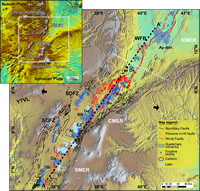The origin of along-rift variations in faulting and magmatism in the Ethiopian Rift
Keir D., I.D. Bastow, G. Corti, F. Mazzarini, T.O. Rooney.
Tectonics, Volume 34, Issue 3, Pages 464–477, doi:10.1002/2014TC003698.
Abstract
The geological record at rifts and margins worldwide often reveals considerable along-strike variations in volumes of extruded and intruded igneous rocks. These variations may be the result of asthenospheric heterogeneity, variations in rate, and timing of extension; alternatively, preexisting plate architecture and/or the evolving kinematics of extension during breakup may exert first-order control on magmatism. The Main Ethiopian Rift (MER) in East Africa provides an excellent opportunity to address this dichotomy: it exposes, along strike, several sectors of asynchronous rift development from continental rifting in the south to incipient oceanic spreading in the north. Here we perform studies of volcanic cone density and rift obliquity along strike in the MER. By synthesizing these new data in light of existing geophysical, geochemical, and petrological constraints on magma generation and emplacement, we are able to discriminate between tectonic and mantle geodynamic controls on the geological record of a newly forming magmatic rifted margin. The timing of rift sector development, the three-dimensional focusing of melt, and the ponding of plume material where the rift dramatically narrows each influence igneous intrusion and volcanism along the MER. However, rifting obliquity plays an important role in localizing intrusion into the crust beneath en echelon volcanic segments. Along-strike variations in volumes and types of igneous rocks found at rifted margins thus likely carry information about the development of strain during rifting, as well as the physical state of the convecting mantle at the time of breakup.
http://onlinelibrary.wiley.com/doi/10.1002/2014TC003698/full


